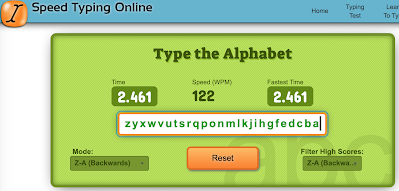Learning About My Brain From Typing Z-A
Recently, I challenged my girlfriend to see who could type A-Z the fastest on Speed Typing's "Type the Alphabet" page. She won :( Regardless, I loved how the site presented the results so clearly and colorfully.
I then thought, "Hmm, I can use this site to study how my brain works." I'll just keep repeating this simple task to try out new techniques and observe how my performance changes.
zyxwvutsrqponmlkjihgfedcba
My first attempt was 8.177 seconds (38 WPM). After just 20 minutes mixed with deliberate practice and free typing, I managed to achieve 3.028 seconds (103 WPM), a 170% improvement. Towards the end, typing Z-A started to feel natural, almost like breathing or simply moving my fingers!
Daniel Kahneman describes two modes of thinking in Thinking, Fast and Slow: 'fast' mode, where thinking is instinctual (subconscious), and 'slow' mode, where thinking is deliberate (conscious). These modes perfectly matched my experience before/after these 20 minutes. My brain followed the progression below, which I'll expand on next.
(100% slow mode) --> (familiar chunks + slow mode) --> (more chunks) --> (100% fast mode)
Starting with Familiar Chunks
First, my brain boosted my typing performance by identifying chunks, meaningful groups of letters, that were familiar to me. For example, I recognized "cba" from "collective bargaining agreement", a term I had frequently seen in NFL and NBA news. In fact, "cba" was easier to type than the letter "q" itself, since I rarely located single letters in my daily typing. Remarkably, my brain located existing chunks with no conscious effort on my part.
Deliberate Practice to Build Unfamiliar Chunks
I soon ran out of familiar chunks, though. At this point, I could either hope to build some muscle memory, or I could direct my brain to focus on building unfamiliar chunks. "zyxwvuts" was the perfect candidate, since I needed to type this chunk correctly at the beginning of all my runs.
The process of focusing on a specific chunk for practice is known as deliberate practice. The concept is obvious: why waste time going through what you can already do well, when you can focus on what you suck at? Well, this concept is hard for the human brain to understand and accept. My brain kept wanting to type the complete sequence to get the 20 minutes over with, while I knew in theory that practicing 'zyxwvuts' would better boost my speed. In general, working on weaknesses takes conscious effort -- one must override the brain's tendency to do what it's familiar with.
Here is my final chunk breakdown of zyxwvutsrqponmlkjihgfedcba.
- zyxwvuts - Deliberate practice.
- rqponml - No deliberate practice. Got somewhat fluent since I needed to type this segment to complete the Z-A task. Remains my weakest segment.
- kjihg - kj and hg are neighbors in Dvorak. Fun to type.
- fed, cba - Common words. Also fun to type.
Retention
- After a 10 minute break: 4.618 seconds (68 WPM).
- After an hour break: First attempt: 5.274 seconds (59 WPM). Second attempt: 3.516 seconds (89 WPM).
- After sleep: First attempt: 3.311 seconds (94 WPM)!? After 7 attempts (some failures), I was able to get to 2.657 seconds (117 WPM).
- After a few days: 3.382 seconds (94 WPM). Second attempt: 2.384 seconds (131 WPM).
I've found that retention vs. time spent is not a linear relationship. With just a bit of upfront effort, I developed a skill that I could perform again much later.




Comments
Post a Comment